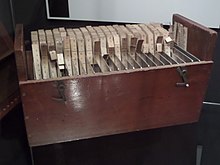Henry Lipson
Henry (Solomon) Lipson | |
|---|---|
| Born | 11 March 1910 |
| Died | 26 April 1991(aged 81) |
| Nationality | British |
| Alma mater | |
| Known for | |
| Scientific career | |
| Fields | Physics |
| Institutions | |
Henry (Solomon) LipsonCBEFRS[1](11 March 1910 – 26 April 1991) was a Britishphysicist.He was Professor of Physics,Manchester Institute of Science and Technology,1954–77, thenprofessor emeritus.[2]
Background
[edit]Lipson was born inLiverpool,England,into a family of Polish Jewish immigrants. His father was a steelworker at the Shotton works in Flintshire. His mother was very insistent about the importance of education and ensured that he attendedHawarden Grammar Schoolwhere he won a scholarship and exhibition to study physics atLiverpool University.He graduated with First Class Honours in 1930 and stayed on to do research at Liverpool into crystal structures usingx-ray diffraction.
Career
[edit]University of Liverpool
[edit]His research into crystal structures usingx-ray diffractionbecame his primary research interest, and in this research he teamed up withArnold Beeversand sought advice from ProfessorLawrence Bragg(who had established a major crystallographic centre in Manchester). Whilst at Liverpool, and without significant funding Beevers and Lipson made most of their own equipment and invented an aid to calculation,Beevers-Lipson Strips,which were widely used in the days before computers and which made their names well known within the field.[3]
University of Cambridge
[edit]In 1936, Bragg invited Lipson to move toManchester,and he later followed Bragg in moves toTeddingtonand then, when Bragg becameCavendish Professorin 1937, toCambridge.In Teddington in 1937 he married Jenny Rosenthal (23 January 1910 – 2009)

In practical terms, Lipson was in charge of the crystallography group in Cambridge, and took on a key role in nurturing young scientists. Whilst at the Cavendish he became convinced by contact with P. P. Ewald of the importance of theFourier transformin X-ray crystallography.
Manchester Institute of Science and Technology
[edit]He was awarded a Liverpool DSc in 1939 and a Cambridge MA in 1942, but he never really integrated intoUniversity of Cambridgelife and he moved to the Manchester College of Technology (later University of Manchester Institute of Science and Technology) in 1945 as head of the physics department.
The position carried no title or status, but under his direction it quickly became a world centre for crystallographic research pioneering optical approaches to x-ray diffraction based on the Fourier transform. In 1954 he was made a professor and in 1957 he was made aFellow of the Royal Society.[1]He officially retired in 1977 but remained active in the department.
Lipson had a strong belief in the social responsibility of scientists, was an active member ofScientists against Nuclear Armsand was twice president of theManchester Literary and Philosophical Society.[citation needed]He was appointed aCBEin 1976.
Evolution
[edit]Lipson was a proponent ofevolutionary creation.He authored a paperA Physicist Looks at Evolutionwhich was widely quote-mined bycreationists.[5]Lipson was a critic ofDarwinismbut did not deny that species have evolved. TheNew Scientistquoted him as saying "I do not accept theGenesisaccount of creation as anything more than pleasing fantasy. My idea of creation is much subtler, but since it is not scientific (in the sense that it cannot be tested) I shall not expound it here. "[6]
Selected publications
[edit]- Lipson, H.;Beevers, C. A.(1935)."The crystal structure of the alums".Proceedings of the Royal Society of London. Series A, Mathematical and Physical Sciences.148(865): 664–680.Bibcode:1935RSPSA.148..664L.doi:10.1098/rspa.1935.0040.
- Lipson, H.; Taylor, A. (1939)."Defect lattices in some ternary alloys".Proceedings of the Royal Society of London. Series A. Mathematical and Physical Sciences.173(953): 232–237.Bibcode:1939RSPSA.173..232L.doi:10.1098/rspa.1939.0141.
- Edwards, Olive S.; Lipson, H. (1942). "Imperfections in the structure of cobalt. I. Experimental work and proposed structure".Proceedings of the Royal Society of London. Series A. Mathematical and Physical Sciences.180(982): 268–277.Bibcode:1942RSPSA.180..268E.doi:10.1098/rspa.1942.0039.S2CID120675954.
- Lipson, H.; Stokes, A. R. (1942). "The structure of graphite".Proceedings of the Royal Society of London. Series A. Mathematical and Physical Sciences.181(984): 101–105.Bibcode:1942RSPSA.181..101L.doi:10.1098/rspa.1942.0063.S2CID138148864.
- Daniel, Vera; Lipson, H. (1943). "An X-ray study of the dissociation of an alloy of copper, iron and nickel".Proceedings of the Royal Society of London. Series A. Mathematical and Physical Sciences.181(987): 368–378.Bibcode:1943RSPSA.181..368D.doi:10.1098/rspa.1943.0014.S2CID96813847.
- Daniel, Vera; Lipson, H. (1944). "The dissociation of an alloy of copper, iron and nickel Further X -ray work".Proceedings of the Royal Society of London. Series A. Mathematical and Physical Sciences.182(991): 378–387.Bibcode:1944RSPSA.182..378D.doi:10.1098/rspa.1944.0012.S2CID97395157.
- Lipson, H. S.; Taylor, C. A. (31 August 1961)."Optical models of crystal structures".New Scientist.11(250): 513–517.
- Lipson, Henry (1984).The study of metals and alloys by X-ray powder diffraction methods.University College Cardiff Press.
- Lipson, Henry Solomon (1990). "Reminiscences and discoveries, the introduction of Fourier methods into crystal-structure determination".Notes and Records of the Royal Society of London.44(2): 257–264.doi:10.1098/rsnr.1990.0021.S2CID123077861.
References
[edit]- ^abWoolfson, M. M.(1994)."Henry Solomon Lipson. 11 March 1910 – 26 April 1991".Biographical Memoirs of Fellows of the Royal Society.39:228–244.doi:10.1098/rsbm.1994.0014.
- ^Lipson, Henry; Ariel Lipson; Lipson, Stephen H. (2011).Optical physics(4th ed.). Cambridge, UK: Cambridge University Press.ISBN978-0-521-49345-1.(1st edition, 1969)
- ^Gould, Bob (December 1998)."The mechanism of Beevers–Lipson strips".iucr.org.International Union of Crystallography.Retrieved28 March2014.
- ^"Set of Beevers Lipson Strips, Sine Set, c.1936".Oxford:Museum of the History of Science.Retrieved28 March2014.
- ^"The Quote Mine Project".Talk.Origins.
- ^Cherfas, Jeremy. (1982).The best of both worlds: Jeremy Cherfas has been casting through readers' letters on natural selection and religion.New Scientist,11 March. p. 656
- 1910 births
- 1991 deaths
- Alumni of the University of Liverpool
- Academics of the University of Liverpool
- Academics of the University of Manchester Institute of Science and Technology
- British crystallographers
- British physicists
- Commanders of the Order of the British Empire
- Fellows of the Royal Society
- Manchester Literary and Philosophical Society
- Jewish British scientists
